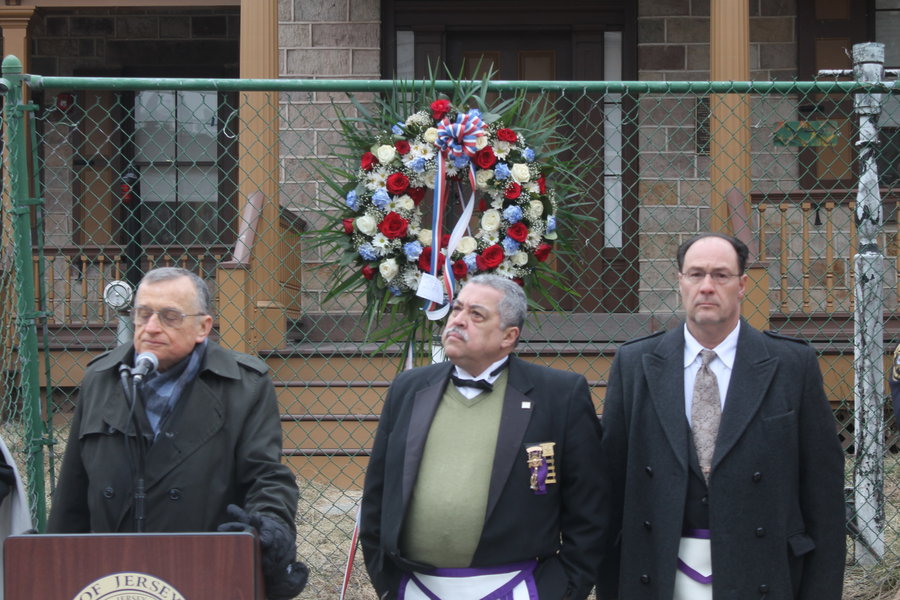Legend has it that General George Washington met with French Major Gen. Marquis de Lafayette in 1779 in the midst of the American Revolution to discuss war plans under an apple tree in Jersey City. The tree was planted in the front yard of house owned by Harman Van Wagenen, a Jersey City farmer.
While the tree existed on the property that is now called “The Apple Tree House,” the legend — like the famous story about Washington chopping down the cherry tree as a boy — is not completely accurate.
While Washington and Lafayette did meet in Jersey City a number of times during the war, their encampment was in one of the apple orchards more remote from the house, according to Edward C J. Meehan, president of the George Washington Society of Jersey City.
Meehan and others came out to celebrate Washington’s Birthday on a blustery and frigid President’s Day, Feb. 15, as part of an annual wreath-laying ceremony.
The handful of people gathered for the event included veterans, members of the Knights of Columbus, the Free Masons, and an honor guard supplied by the Hudson County Sheriff’s office.
The Apple Tree House stands a few blocks from Journal Square, but more importantly, it is near Sip Avenue and the former estate of the Sip family.
Meehan said the Van Wagenen family were patriots on the side of Washington, while the Sip family were Tories, and during this same period when Washington and Lafayette were encamped on the Van Wagenen estate, British General Charles Cornwallis was housed at the Sip home a short distance away.
“I’m hoping that by next year this time we can hold the ceremony inside.” – Edward C J Meehan said.
____________
“Most people don’t associate Jersey City with the Revolutionary War,” Meehan said. “But this place was significant.”
Some of these meetings eventually led to a battle that occurred elsewhere in Jersey City at Paulus Hook.
A piece of history
The apple tree that the legend made famous fell during a storm on Sept. 3, 1821. People came from far and wide to collect pieces of the tree as souvenirs. Some kids whittled its wood into various objects for gifts around Christmas time.
In 1824, Lafayette returned to New Jersey as an old man to tour places he had shared with Washington, including Paterson and Jersey City. This was a huge historic event for Jersey City and the state, since Lafayette was considered as much a hero of the American Revolution as Washington. Some towns in the state such as Cape May name streets after both men in tribute. During his visit to Jersey City that year, local officials presented him with a walking stick made from the wood of the fallen tree. The stick is on display at the Louvre Museum in Paris.
A historic house
In seeking to preserve some of that history, Meehan and others worked to preserve the house, which was later renamed “Apple Tree House.”
Meehan said the idea occurred to him when the house still served as a funeral home back in 1985. He was attending the funeral of Jay Gundry, a long time Jersey City historian, and somehow made the connection that they were standing in a piece of history that ought to be preserved.
“That’s when we formed the George Washington Society of Jersey City,” he said.
In the midst of this effort, however, the house closed and fell into disrepair. The building was scheduled for demolition, and Meehan and others went on a campaign to collect signatures to save the building.
The city eventually purchased the property from Provident Savings Bank with the aim of restoring it for some historic use, possibly as a museum.
Closed to the public since 1990, the city sought funds for what eventually became a $4.1 million restoration project. The restoration has been underway since 2002 under the careful eye of Jersey City Landmarks Committee. Currently, the all of the building restoration has been completed with only the landscaping remaining.
“I’m hoping that by next year this time we can hold the ceremony inside,” Meehan said.
Phase III of the restoration includes landscaping and other exterior fixes and is being paid for by a $700,000 grant.
The use of the building constructed in 1740 is still uncertain, although the city has also suggested it might serve as the center for the city’s Office of Cultural Affairs.
Al Sullivan may be reached at asullivan@hudsonreporter.com.
